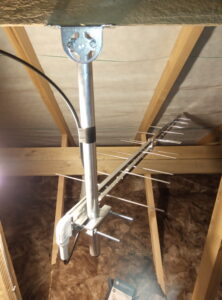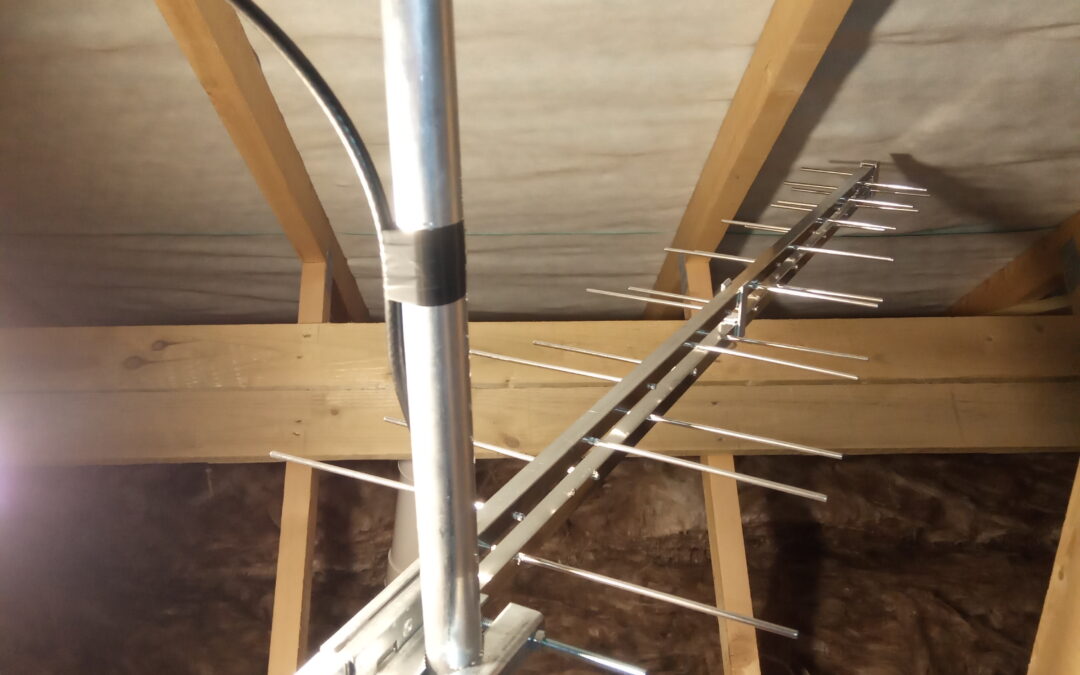There are several situations where the pros and cons set forth by an indoor aerial greatly outweigh those of an outdoor aerial, and vice versa. In either case, outdoor and indoor TV aerials may provide benefits that are equal to one another, depending on the location and layout your specific residence. Let’s take a quick look at both TV aerial setups, and discuss the differences between outdoor roof mounted and indoor loft aerials, specifically.
Comparing Roof Mounted TV Aerials to Loft Aerials
Table of Contents
In most cases, particularly within the Stockport area (Click here), indoor loft TV aerials are typically considered the superior option, especially when compared to outdoor roof mounted aerials. Over the many years spent installing TV aerials, professionals learn a few things when it comes to overall functionality and longevity. For example, newer residential developments are setup for a loft TV aerial – unless you have a Sky (or Virgin) subscription. Newer construction features pre-existing wiring with pre-determined embedded TV points – which run up into the loft space. In situations such as this, the need for roof mounted aerials becomes redundant.
The benefits of indoor loft TV aerial installations are plentiful, eliminating the need for unsightly equipment in, and around your home. Residents will appreciate the lack of various cables trailing along walls, ceilings, roofs, and even flooring. Additionally, this type of TV aerial installation goes great lengths in preventing subsequent damage resulting from storms, or excess flood water. For these specific reasons, a loft TV aerial makes an excellent choice.
How Signal Strength Might be Affected

loft aerial fitted in new build property in Stockport
As explained above, indoor loft TV aerials have a lot to offer homeowners in regard to unsightly equipment, as well as overall storm safety. And, while it is a common misconception that outdoor roof mounted aerials receive a stronger signal than that provided by indoor loft aerials, it isn’t necessarily the case. In reality, there is no real distinguishable difference in picture quality with roof mounted aerials compared to loft installations. Back in 2012, the UK made the move toward a more robust system, through a switch to digital from analogue. To put it plainly, with a digital signal, the picture is either on or off. An analogue signal has a lot of “in between” moments, where your TV may display a poor picture. Because a digital signal operates on an on or off system, the location of a TV aerial won’t affect the picture quality too much – compared to analogue.
My Place of Residence Doesn’t Have a Loft
Older homes most likely won’t offer embedded TV points throughout any part of the house, let alone feature a loft space. On the off chance your house offers a loft, cables will most likely be visible running up the wall to the loft. If your residence lacks a loft, you will need to depend upon an outdoor roof mounted TV aerial in order to receive any sort of signal. Thankfully, most aerial installers offer discreet TV aerial installation options, in order to minimize unsightly wires, and excess equipment. In fact, one alternative option involves the use of an aerial known as a log period aerial. These small, minimal aerial designs are rather discreet, providing a relatively clean signal – while also filtering out unwanted noise.
How is it possible to complete a discreet TV aerial installation, you might ask? By utilizing clever install techniques, wiring may be hidden from view behind guttering, pipes, and more. For example, we utilize a smaller mast (3 to 4 feet), rather than a tall mast (12 feet), in order to avoid creating a large eyesore. Some of our more discreet installation accomplishments include buildings that are not lawfully permitted to have an external TV aerial on display.
Situations Where Roof Mounted TV Aerials are the Best Option
In the event where an outdoor TV aerials would serve as a better option, your installer will be able to offer a few options. Unfortunately, because some areas receive a poor Digital Terrestrial Signal due to various compromises, indoor TV aerials aren’t realistic. In the Northwest area of the UK, fewer homes suffer from signal weaknesses for a few reasons. These causes may include:
- Land formations, such as hills and valleys. Natural terrain such as this tend to compromise the digital TV signal, causing poor reception on TV aerials of indoor installations. Sometimes a poor signal may be remedied by use of a tall mast, in addition too a mast head amplifier, or MHA. An installation such as this would utilize roof mounted aerial.
- Places of residence located near a busy motorway, may receive weakened TV signals due to static noise interference. In areas close to a high traffic area, outdoor TV aerials may prove most useful, compared to loft installations, in order to avoid such interference.
- Other various types of interference, especially in regard to property located near infrastructure (such as overhead train cables and pylons), aren’t a good candidate for indoor TV aerials. In this situation, a roof mounted aerial will be your best bet – if not your only possible option.
Let the Professionals Make an Appropriate Determination
If you find yourself in the market for a new TV aerial installation, whether indoor or outdoor, place your home in the trustworthy hands of a professional. Contacting a TV aerial pro ensures the best possible installation options for your property. Professionals utilize equipment and techniques best suited for your specific situation, as well as avenues which go great lengths in providing the highest quality reception possible. We offer free estimates and advice, in order to supply the strongest foundation attainable by your home, and location.
TV Aerials Stockport. Houldsworth Business & Arts Centre, Houldsworth St, Stockport SK5 6DA.
Tel: 0161 883 3687


Recent Comments